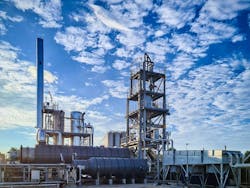Orion Breaks Ground on Battery Materials Plant in Texas
Specialty chemicals firm Orion S.A. has broken ground near Houston on a site planned to manufacture conductive additives for the most common batteries in electric vehicles and utility-scale battery storage.
Orion’s future plant in La Porte will produce acetylene-based conductive additives, which the company says will be the only such facility in the U.S. Orion has a similar plant operational in France.
“Orion is already the sole producer of acetylene-based conductive additives in Europe,” Orion CEO Corning Painter said in a statement to celebrate the groundbreaking. “Our plant in La Porte will be a pivotal step toward strengthening the regional supply of conductive additives in the rapidly growing U.S. battery market.”
Orion is the latest of numorous global battery technology firms to plan manufacturing sites in the U.S. in the wake of the incentives from the Inflation Reduction Act. Those companies include LG, AESC and FREYR, among others.
Batteries require conductive additives which heighten flow of electricity from the lithium-ion batteries. Lithium chemistries dominate the battery markets with close to 90% of market share, according to reports.
Every battery requires conductive additives. They enable a more efficient flow of electricity and extend the lifetime of lithium-ion batteries – the most valuable components of electric vehicles. The material also plays an essential role in high-voltage cables used for wind and solar farms.
The additives produced at the La Porte plant will be made from acetylene, a colorless gas that Orion’s production process turns into powder with exceptional purity demanded by leading battery manufacturers. The acetylene will be supplied by a neighboring site owned by Equistar Chemicals LP, a subsidiary of LyondellBasell (LYB).
“At LYB, we see electrification as a crucial part of our plan to reduce carbon emissions across our industries,” Kim Foley, LyondellBasell executive vice president of global olefins and polyolefins, said in a quote from the groundbreaking. “By supporting the production of key battery components, we’re contributing to solutions for a better tomorrow.”
Construction activities are ramping up. Orion hopes to start operations at the facility in the second quarter of 2025.
The U.S. customer enthusiasm for electric vehicles has cooled somewhat in the past year, but most market forecasts still predict vast growth in sales and revenues for EV and battery storage companies over the rest of this decade.
About the Author
Rod Walton, EnergyTech Managing Editor
Managing Editor
For EnergyTech editorial inquiries, please contact Managing Editor Rod Walton at [email protected].
Rod Walton has spent 17 years covering the energy industry as a newspaper and trade journalist. He formerly was energy writer and business editor at the Tulsa World. Later, he spent six years covering the electricity power sector for Pennwell and Clarion Events. He joined Endeavor and EnergyTech in November 2021.
Walton earned his Bachelors degree in journalism from the University of Oklahoma. His career stops include the Moore American, Bartlesville Examiner-Enterprise, Wagoner Tribune and Tulsa World.
EnergyTech is focused on the mission critical and large-scale energy users and their sustainability and resiliency goals. These include the commercial and industrial sectors, as well as the military, universities, data centers and microgrids. The C&I sectors together account for close to 30 percent of greenhouse gas emissions in the U.S.
He was named Managing Editor for Microgrid Knowledge and EnergyTech starting July 1, 2023
Many large-scale energy users such as Fortune 500 companies, and mission-critical users such as military bases, universities, healthcare facilities, public safety and data centers, shifting their energy priorities to reach net-zero carbon goals within the coming decades. These include plans for renewable energy power purchase agreements, but also on-site resiliency projects such as microgrids, combined heat and power, rooftop solar, energy storage, digitalization and building efficiency upgrades.


